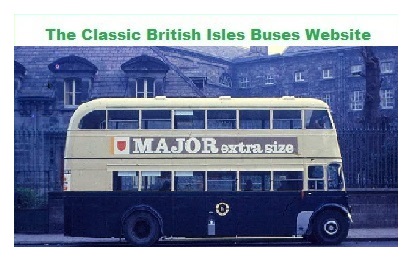

The Classic British Isles Buses Website
Coras Iompair Eireann 1956 to 1961 (by Shane Conway)
Page last updated on 19 August 2024
Email Classic U.K. Buses Classic Irish Buses Classic Manx Buses
| 1945-1950 | 1951-1955 | 1956-1961 | 1962-1966 | 1967-1970 | 1971-1981 | CIE adverts 1957 | Bombardiers (KC, KD, KE, KR and KW) |
By the mid 1950s CIE had largely replaced all of its pre-war single deck buses and coaches with newer, larger vehicles, as well as increasing its stock of double deckers. The only losses in that section of the fleet had been the ex Great Southern Railway petrol engined RP class Leyland Titans, in 1949 and 1950, and the six 1946 Daimlers, whose bodies had been fitted to new Leyland OPD2s in 1954. The end of 1955 had seen the first Leyland OPD2/10s enter service, and thus the first buses with air brakes as opposed to the vacuum brake systems of older vehicles. At this point too the withdrawal of the pre-war ex Dublin United Transport Leyland Titans commenced, with numbers R22, 36, 105-07, 112, 114, 152 and 168 having been taken out of service by the end of that year. R36 subsequently joined the Lough Swilly fleet in Donegal as the only pre-war decker ever owned, and outlived the last of its contemporaries by three years.
Production of CIE buses from 1956 to 1961 was exclusively of double deckers, and 377 Leyland Titans and three AEC Regents entered service in the period. Of the 225 66 seater OPD2s, a number were modified with platform doors during the 1960s for rural services outside of Dublin, and a few of these also were down-seated to 64 when luggage racks were fitted in the lower saloon. So far 26 of this batch of Titans (R674 - 681, 691, 696, 710, 743, 746, 766 to 773, 782, 783, and 785 - 787) are known to have been converted, joining R565 to 574 which were fitted with doors from new.
Following the demonstration of Edinburgh Corporation's NSF 721 in 1957, some of its features were adopted by CIE. In particular the two front seats in the lower deck were replaced by a rearwards facing bench for five passengers, and the double seat above the platform was replaced by a triple seat. The concealed radiator and full width bonnet was later adopted on the larger RA class PD3s. The increase of two seats was then added to older buses as overhauls became due, and was fitted to all buses from R748 onwards on the production line. The one exception to the television seat (as it became known) in the lower saloon was in R575 to R580 as these were only 7'6" wide. Buses R791, 792 and 798 were fitted with semi-automatic gearboxes and this was adopted as standard on the RA class Leyland PD3/2s of 1959 to 1961. R799 to R833 reverted back to a two window layout at the front of the upper deck, rather than the triple window design of most of the rest of the fleet.
20 of the DUTC buses lasted into the 1960s (just!), with the last few survivors being withdrawn in October 1960. R80 was one of the last twenty, and it was allocated to Summerhill garage when the then new RA80 was delivered there. RA80 was also still in Summerhill in 1982 when Bombardier KD80 arrived, in effect giving a unique record of 59 years service by three generations of buses with the same numerals, from the same garage, up to when KD80 was withdrawn in June 1998
RA137, unlike the rest of the fleet, was delivered in a new livery of blue and cream in April 1961. By the end of the year five of the R class had also been repainted in the new livery, and from then until 1968, virtually all of the Titan and Regent fleet was so treated. By then production of the next generation of CIE double deckers, the D class Leyland Atlanteans, was well underway, and the fleet of half cabs was gradually whittled away through the 1970s. Half-cab farewell journeys were made in Dublin by RA4 on route 8 in December 1981, and by RA138 on route 23 in March 1982. The real end came in April 1982 when the last pair of all, RA33 and 95 were replaced at Clontarf garage by KD140 and 141.
1961 also saw the introduction of CIE's first Leyland Leopards, the E class, as well as their last new AECs. The latter comprised three Regent V 69 seaters, which replaced trains on the Waterford to Tramore line. A total of 32 Leopards entered service in 1961, to be followed by a further 138 of the same design over the following three years. Further details of these are covered in the 1962 to 1966 page.
1956
U45 - U50 were named after Irish rivers, as follows:
| U45 | The Kenmare | U46 | The Lagan | U47 | The Laune |
| U48 | The Maigue | U49 | The Tolka | U50 | The Valentia |
1957
1958
Summary of buses acquired from Great Northern Railway 10/1958 (click here for a detailed GNR history)
1959
1960
1961
Total fleet = 525 (367 new and 158 ex Great Northern Railway) with 25 survivors (A427, AA2, AR438, AU274, AU345, E7, E8, E14, E18, G324, G387, G389, G390, G396, R637, R657, R686, R788, R819, R827, RA30, RA35, RA37, RA73, # RA105 and RA106).
Email Classic U.K. Buses Classic Irish Buses Classic Manx Buses